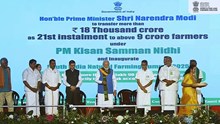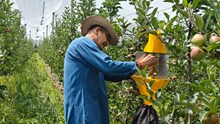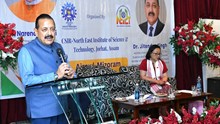
In her Union Budget 2025-26 presentation in Parliament on February 1, 2025, Union Minister for Finance and Corporate Affairs Nirmala Sitharaman highlighted the importance of agriculture as the ‘First Engine of India’s Development Journey.’ She unveiled a series of initiatives aimed at boosting agricultural growth and productivity, ultimately benefiting the nation's farmers, or ‘Annadata.’
Union Budget 2025-26: Key Highlights for the Agriculture Sector
1. Makhana Board in Bihar
One of the major announcements included the creation of a Makhana Board in Bihar. The board is aimed at boosting production, processing, value addition, and marketing of makhana, while supporting farmers through Farmer Producer Organizations (FPOs). Additionally, the board will provide training and ensure farmers gain access to relevant government schemes.
2. Prime Minister Dhan-Dhaanya Krishi Yojana - Developing Agri Districts Programme
The programme to be launched in partnership with the states, covering 100 districts with low productivity, moderate crop intensity and below-average credit parameters, to benefit 1.7 crore farmers.
3. Building Rural Prosperity and Resilience
A comprehensive, multi-sectoral program will be launched in partnership with states to tackle underemployment in agriculture by focusing on skill development, investment, technology, and revitalizing the rural economy. Phase 1 will target 100 developing agricultural districts.
4. Mission for Aatmanirbharta in Pulses
Government to launch a 6-year 'Mission for Aatmanirbharta in Pulses' with focus on Tur, Urad and Masoor. NAFED and NCCF to procure these pulses from farmers during the next 4 years.
5. National Mission on High Yielding Seeds
The Minister also revealed the launch of a National Mission on High Yielding Seeds, designed to improve research, development, and propagation of high-yield, pest-resistant, and climate-resilient seed varieties. The mission will help commercialize over 100 seed varieties released since July 2024.
6. Gene Bank
To safeguard genetic resources for future food and nutritional security, the government will establish a second Gene Bank, which will house 10 lakh germplasm lines.
7. Mission for Cotton Productivity
A special initiative, the ‘Mission for Cotton Productivity’, was also introduced. This 5-year mission aims to significantly increase cotton productivity and sustainability, with a focus on promoting extra-long staple cotton varieties. The mission will benefit millions of cotton farmers and help revitalize India's traditional textile industry.
8. Enhanced Credit through KCC
The government is also enhancing the Kisan Credit Card (KCC) scheme. The loan limit under the Modified Interest Subvention Scheme will rise from Rs. 3 lakh to Rs. 5 lakh for loans obtained through KCC, benefiting millions of farmers, fishermen, and dairy farmers.
9. Comprehensive Programme for Vegetables & Fruits
A comprehensive programme to promote production, efficient supplies, processing, and remunerative prices for farmers to be launched in partnership with states.
10. New Urea Plant in Assam
To strengthen the country’s urea production capacity, Sitharaman announced the establishment of a new urea plant in Namrup, Assam, with an annual capacity of 12.7 lakh metric tons. This move aims to further reduce dependency on imports and boost Atmanirbharta in urea production.
The Union Budget 2025-26 outlines a roadmap for the agriculture sector, with an emphasis on sustainable growth, improved productivity, and rural development. The measures proposed include the creation of specialized boards and missions, the promotion of high-yielding seeds, and the support for sustainable fisheries. These initiatives are intended to support farmers, enhance food security, and strengthen the agricultural sector, contributing to the broader goal of economic resilience and self-reliance.
Strengthening India's Agricultural Backbone: Key Achievements & Government Initiatives
Agriculture is central to India's economy, ensuring food security, providing employment, and driving growth. It supports a large portion of the population and is key to the nation's socio-economic stability. The government has prioritized the sector with increased initiatives and funding.
-
The Government of India has significantly increased budget allocations, rising from Rs 11,915.22 crore in 2008-09 to Rs 1,22,528.77 crore in 2024-25, demonstrating its commitment to the sector.
-
Food grain production has surged from 204.6 million tonnes (2004-05) to an estimated 332.3 million tonnes (2023-24), with enhanced productivity and Minimum Support Price (MSP) revisions ensuring better farmer incomes.
-
The MSP for paddy and wheat has grown from Rs 850 and Rs 1,080 per quintal in 2008-09 to Rs 2,300 and Rs 2,425 per quintal in 2023-24 respectively. Additionally, the total MSP paid to farmers for paddy and wheat has surged from Rs 4.40 lakh crore and Rs 2.27 lakh crore in 2004-13 to Rs 12.51 lakh crore and Rs 5.44 lakh crore in 2014-24 respectively.
-
Key farmer-centric initiatives include PM-KISAN (Rs 3.46 lakh crore disbursed), PMFBY (Rs 1.65 lakh crore in claims), and e-NAM, which has integrated 1,400+ mandis for better market access. The Agricultural Infrastructure Fund (AIF) has sanctioned Rs 52,738 crore for over 87,500 projects to improve post-harvest management.
-
The government’s millet promotion efforts have boosted production, while institutional credit expansion, Kisan Credit Card (KCC) growth, and agricultural R&D investments continue to transform the sector.
















